The main reasons behind a Heatilator gas fireplace won’t stay lit are no pilot light, clogged thermocouple or thermopile, malfunctioning oxypilot, dirty burner ports, and drip loop.
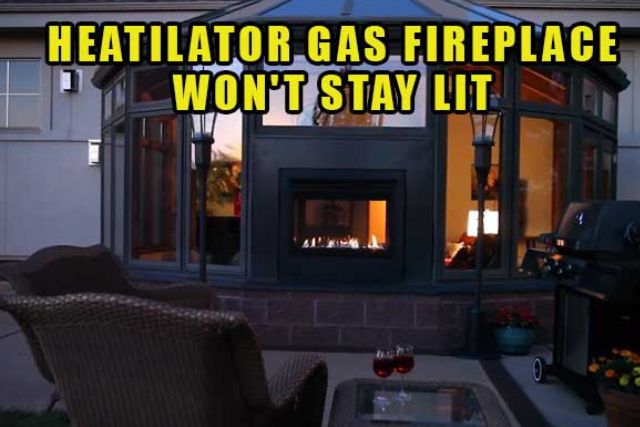
You can solve this problem in most cases by reigniting the pilot light or cleaning the thermocouple and thermopile. However, that doesn’t mean you should ignore the other issues behind it as they’re quite common as well.
Keep reading this Heatilator gas fireplace troubleshooting guide to find out all about these issues in detail and learn how you can fix them. Let’s dive in!
Table of Contents
- Heatilator Gas Fireplace Won’t Light Or Stay Lit [5 Easy Fixes]
- 1. No Pilot Light
- 2. Clogged Thermocouple Or Thermopile
- 3. Malfunctioning Oxypilot
- 4. Dirty Burner Ports
- 5. Drip Loop
- FAQ:
- How to turn off the pilot light in a Heatilator fireplace?
- What should you do if you smell gas around your fireplace?
- How do you know if you have the right pilot color?
- Should you use water to clean fireplace components?
- How often should you maintain your fireplace?
- Should you be worried if the pilot light goes bad in a gas fireplace?
- Is it safe to leave the fireplace turned on overnight?
- Will a Heatilator fireplace work with power interruption?
- Conclusion
Heatilator Gas Fireplace Won’t Light Or Stay Lit [5 Easy Fixes]
We’ll discuss the most common reasons why your Heatilator gas fireplace doesn’t light up or fails to stay lit in this section.
Note: You can also read our guide on heatilator gas fireplace manual.
1. No Pilot Light
If your Heatilator gas fireplace won’t light at all, the first thing you need to check is if whether the pilot light is lit or not.
The pilot light is what makes the gas fireplace lights up. Any issues with the pilot light will lead to the fireplace not being lit.

To check whether the pilot light is being lit or not, you’d most likely have to remove the glass decoration of a Heatilator fireplace. Once you do that, you’ll be able to visually inspect whether the pilot light is lit or not.
There are two types of pilot lights mostly used in Heatilator fireplaces – the standing pilot light and the intermittent pilot light. If you have the standing pilot light, you’ll see a separate control knob for the pilot light.
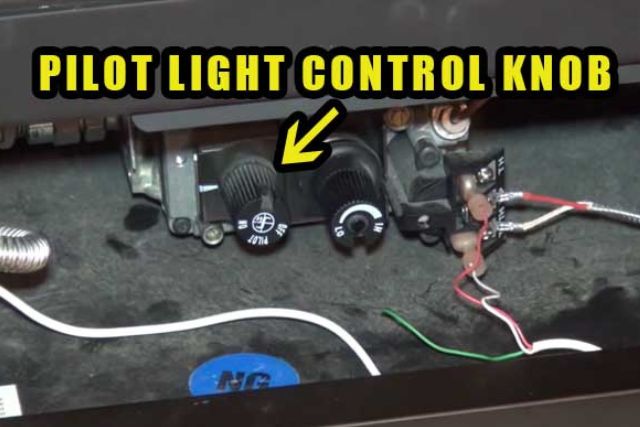
If you don’t see a dedicated knob for the pilot light, it means your model has an intermittent pilot light. Knowing this distinction will help you relight the pilot light if you notice that it’s off.
Solution:
Four things need to be in perfect order for the pilot light to get lit –
- The fireplace must have power.
- The fireplace must have a gas supply at the right pressure.
- The ignitor must be functional and create a spark.
- The pilot light itself must be operational.
Before even checking the pilot light, you need to ensure that some basic things with the fireplace are okay. First of all, make sure that the fireplace is getting power.
Sometimes, the circuit breakers can get tripped and the fuses can get blown. Reset the circuit breaker and replace the fuses in such cases.
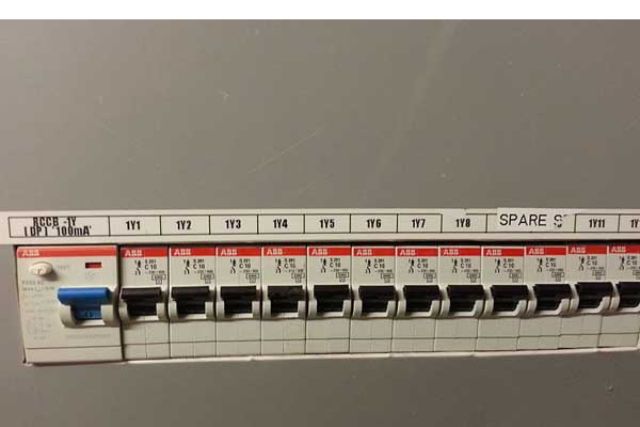
Next, you’d want to check if the ignitor is firing. Manually fire the ignitor and see if it’s creating a spark.
If it doesn’t create a spark, the pilot light won’t light up. Check if the ignition module is plugged in and then, try again. If the ignitor has gone bad, you’ll have to replace it.
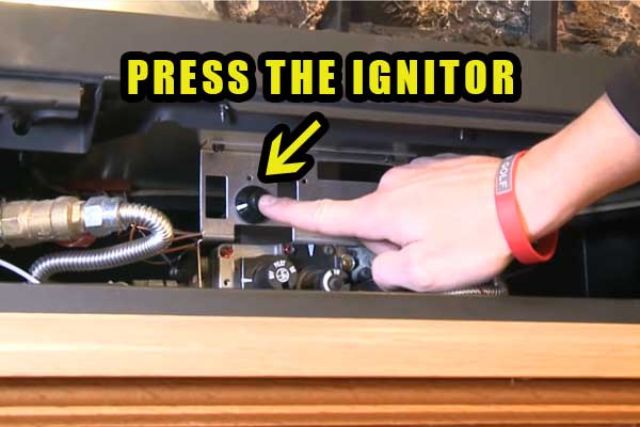
The next thing you should check is whether you have an empty gas tank. Though the Heatilator gas fireplaces are powered electronically, the pilot light needs gas to light.
Make sure that the gas valve is in the “On” position so that you can be sure that the pilot light is getting the proper gas supply.
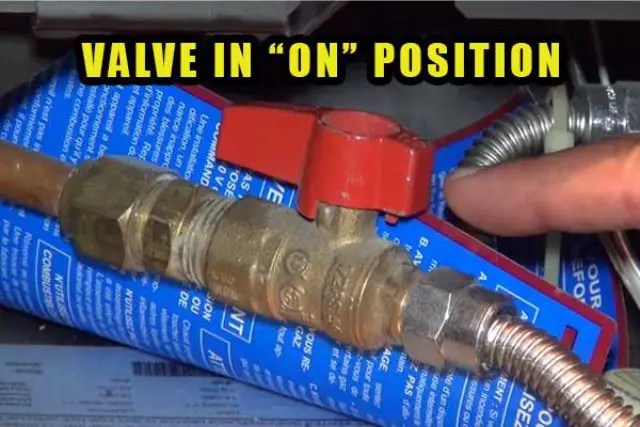
Now, it’s time to address the elephant in the room – the pilot light. If the other things are okay and the pilot light isn’t lit, the first thing you need to try to do is to relight the pilot light.
Here’s a quick step-by-step guide on how you can relight a pilot light in Heatilator gas fireplaces that have a standing pilot light:
Step 1- Remove The Gas Assembly
- Remove the decorative front to access the control components.
- There will be a control knob that has “Pilot”, “On”, and “Off” positions on it if you have a standing pilot light.
- Remove the fixed gas assembly before attempting to relight the pilot light for safety reasons and avoiding any fire hazards.
Step 2- Turn The Pilot Light On

- Check if the ignitor is creating a spark when you press the ignitor button.
- Move the pilot light from the “Off” to the “Pilot” position.
- Hit the ignitor button a few times and the pilot light will turn on. Keep holding the knob for at least half a minute and then, you can release it.
- If the pilot light doesn’t turn on, wait for a few minutes and then try again.
Step 3- Reassemble The Fireplace
- With the pilot light lit up, press the pilot knob and rotate it to the “On” position.
- Reinstall the glass assembly and the decorative front as your fireplace is ready for use now.
- You’re all done here, turn on the fireplace and enjoy.
Once the pilot light is lit up, take a good look at its color. A proper pilot light should have a dark blue color around the edges and a light blue color in the center. There will be a little bit of yellow in it as well.
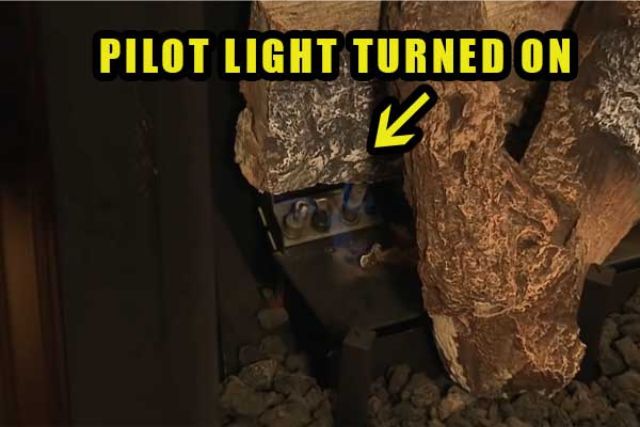
But if you notice a flame that is entirely red or yellow, the gas lighting it up is contaminated and you should turn off your fireplace immediately.
That gas can be contaminated as a result of excess air in the fireplace, burning of rust, oil, dirt, or soot. It can produce toxic chemicals.
A yellow pilot light is also an indicator of a carbon monoxide leak. So, turn off the unit and check if the air is safe to breathe with a carbon monoxide detector.
If the pilot light doesn’t light up despite your attempts or doesn’t have the right color, you should first try to clean it before taking any other steps.
Things like insects and other debris can get into the pilot tubing if it’s left closed for long periods. Here’s how you can clean the pilot light:
- Turn off the circuit breakers and the gas valves of your fireplace.
- Take the pilot light out of the fireplace and clean it with a wire brush.
- Make use of a cleaning duster to loosen up any bits of dirt and debris remaining and remove them. You can also use compressed air for places that are hard to reach.
To prevent this issue from happening, it’s recommended to keep the pilot light open at all times. If cleaning the pilot light solves the issue, you’re good to go. But otherwise, it’s a good idea to call in a mechanic at this point.
That’s because there could be issues with your gas supply that may be difficult for you to diagnose and fix. If you have a broken gas valve or incorrect gas pressure, chances are that you won’t be able to find out about these issues on your own.
There’s a device called a manometer that fireplace technicians use to determine the gas flow through the gas valve. If he senses something is off, he can adjust the gas pressure. He’ll also replace the gas valves if needed.
Even a leak in the gas pipe can cause this issue. A technician has the knowledge to inspect these things one by one. It can cost you a little in the short run but in case there’s a gas leak, he’ll be able to fix the issue and prevent any major damages.
2. Clogged Thermocouple Or Thermopile
If your gas fireplace won’t stay lit but the pilot stays on, the most common culprit behind it is a clogged thermocouple or thermopile. The thermocouple is a safety device and it’s an important component of the ignition system.
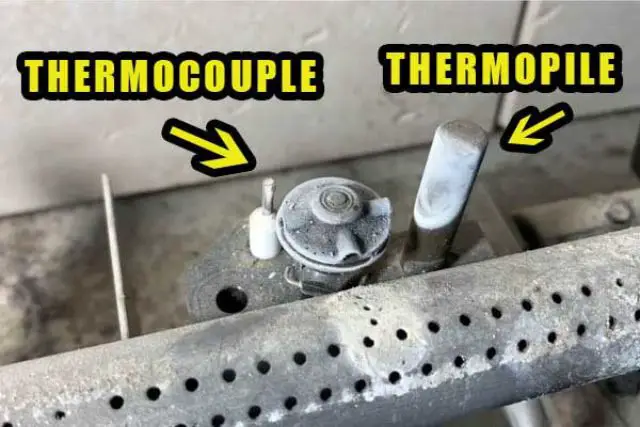
It’s a metal rod that sticks out of the pilot. The thermocouple is essentially a sensor of the gas valve and it supplies gas to the pilot light. On the other hand, a thermopile opens up the gas valve when the fireplace is on.
Both devices are similar as they do the same job of converting heat to electricity. But the thermopile produces more electrical current compared to the thermocouple. Any issues with any of these components can be the reason why the Heatilator gas fireplace keeps shutting off.
The good news is that you can easily check whether you have functional thermocouples and thermopiles if you have a digital multimeter. Here’s how you can do the test:
- Make sure the pilot light has been on for at least a couple of minutes and turn off the fireplace.
- Locate the main gas control valve, find the thermopile sensor and identify the contacts labeled TH/TP and TP. Refer to your owner’s manual if you’re having trouble locating them.
- Place one end of the multimeter leads on the TH/TP contact and the other one on the TP contact.

Now, it’s time to check the results. If the multimeter gives you a reading of 300 millivolts or higher, that means the thermocouple is fine. But if it shows a reading lower than that, it means your thermocouple is malfunctioning.

You can do the same test for the thermocouple. The multimeter will give you a reading of 25 millivolts or higher if you have a good thermocouple. If it reads less than that, your thermocouple isn’t working properly.
Solution:
If the tests show that you have a bad thermopile or thermocouple, don’t replace it right away. You should try cleaning the malfunctioning component first because even a little dirt can keep them from working properly.
And besides, it’s not uncommon at all for them to build carbon deposits after a season of use. They keep burning all the time and it can hamper their effectiveness. Cleaning both of these components is quite easy. You can do it with a stainless steel brush and sandpaper.
Gently remove the faulty component in question and clean as much of it as you can with the brush first. Then, use the fine-grit sandpaper to wipe away any remaining bits of dirt or soot until you’re satisfied with the results.
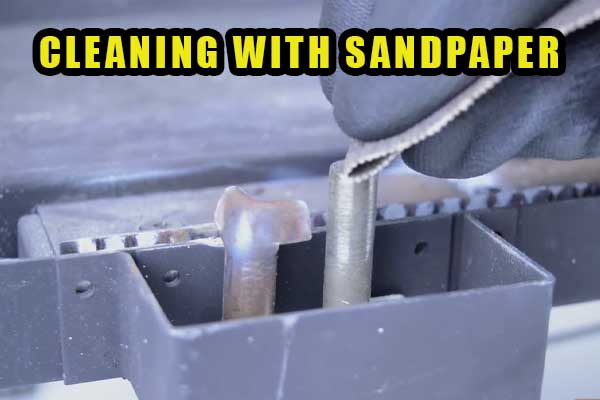
Once you’re happy with how they look, put them in their place and re-ignite the pilot light. After a few minutes have passed, test them again using a multimeter as shown above. If the Heatilator gas fireplace not lighting issue is solved and it works fine, you’re done here.
If cleaning them doesn’t do the trick, your only option is to replace them. Thankfully, both these components are inexpensive and they won’t leave a hole in your wallet.
They’re also easy to replace and you can do them on your own without a technician. It’ll cost you anywhere between $20-$50 if you decide to replace it yourself. But the costs can go up to $70-S150 if you hire a professional.
3. Malfunctioning Oxypilot
If your Heatilator gas fireplace keeps going out within a short time since being turned on, a faulty oxypilot could be the reason behind it.
An oxypilot is a safety device installed in a gas fireplace to protect you from carbon monoxide poisoning. How does it work?
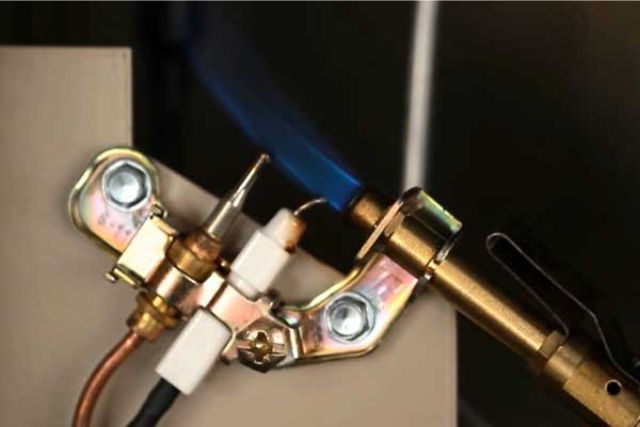
It simply keeps track of how much oxygen is present in the system. When it senses that there’s a low amount of oxygen in the tank, it automatically shuts off the fireplace.
When the quantity of oxygen in the system is low, it indicates a leaking gas tank. And as the leaking gas is carbon monoxide, it’s a good idea to clean the oxypilot at regular intervals so that it doesn’t give faulty readings.
Just like other fireplace components, it’s normal for the oxypilot to collect dirt and debris when it’s used for a long period. In that case, it’ll show faulty readings and makes the Heatilator gas fireplace goes on and off.
Solution:
The first thing you need to check is whether you really have a low amount of oxygen. Check the air with a carbon monoxide detector to confirm that there are no chances of poisoning. If there’s less oxygen in the room, try opening up a door or window to let more air in.
But there are more chances that the oxypilot is measuring a faulty reading and turning off the fireplace. Cleaning it will solve this issue in most cases. You’ll have to remove the oxypilot to clean it and you can do so using a pair of pliers.
Once you take it off, blow some compressed air into the holes of the oxyplilot to get all the dirt out of it. Try lighting the fire and if it still doesn’t work, you’ll have to replace it with a new one. Look up Heatilator gas fireplace parts on Google and find the right part for your model.
4. Dirty Burner Ports
Another potential reason behind the Heatilator gas fireplace won’t light is having clogged burner ports. It’s more likely for the dirty burner ports are more likely to cause uneven heat from your fireplace than make it fail to stay lit.

But on a few occasions, it can still happen. That’s because the carbon deposits inside them can prevent the proper supply of gas. The fireplace will fail to ignite a fire large enough to stay lit and eventually shut off.
Solution:
To fix the Heatilator fireplace won’t stay lit issue, you have to clean the burner ports. It’s an easy process and it’ll only require your time to do it. Follow these steps to clean the burner ports:
- Turn off the pilot light and the gas fireplace. Switch the gas supply valve to prevent any accidents.
- Wait for a few hours for the fireplace to cool down before you start cleaning the burner ports.
- Move all the logs and branches to have access to the burner ports.
- Scrub the burner ports with a soft-bristled scrub brush to make all the soot in it loose and easy to get out.
- Remove the loose soot from them using a handheld vacuum cleaner and repeat this process as many times as needed until you get the dirt out.
- Use compressed air if you need to clean them.
That’s all you need to do to clean them. After that, there should not be any further issues and the gas fireplace should stay lit. Put the logs back in and turn on the fireplace to make sure everything’s okay. It’s a good idea to clean the burner ports at least once every year to avoid these issues.
5. Drip Loop
When there’s moisture in the gas line, the natural gas can easily get diluted. So, a poorer natural gas will flow into the fireplace and it won’t be enough to keep it lit.
Solution:
It’s not recommended that you try solving this problem on your own. Consult a technician in your local area and have him fix this issue for you.
FAQ:
How to turn off the pilot light in a Heatilator fireplace?
You can take off the decorative front from the fireplace to access the control knob of the pilot light. Turn the knob to the “Off” position to turn it off.
What should you do if you smell gas around your fireplace?
Always be safe in this type of situation. Open the doors and windows for the gas to escape. However, if the smell is too strong, leave the house and call your gas provider to look at the issue.
How do you know if you have the right pilot color?
The pilot light should have a steady blue flame. It should be around 90% blue and 10% yellow. If the color is red or yellow, the gas is contaminated.
Should you use water to clean fireplace components?
It’s always recommended that you keep the fireplace components dry when you clean them. Keep it simple and use a toothbrush, soft bristle brush, and rags to clean them. Using chemicals or water on them is a no-go.
How often should you maintain your fireplace?
It’s important to clean your fireplace at the end of each season or at least once a year to prevent serious issues. Proper maintenance will not only save you a lot of stress but also make the fireplace last longer.
Should you be worried if the pilot light goes bad in a gas fireplace?
There could be gas buildup if the gas valve is pumping and the pilot light goes out. It could lead to a fire hazard when the pilot light is reignited. But modern fireplaces have safety features that automatically shut off the gas valve when the pilot light goes out.
Is it safe to leave the fireplace turned on overnight?
You can keep the fireplace turned on overnight if you know that it undergoes regular maintenance. Otherwise, it can lead to carbon monoxide and it’s a good idea to turn it off in that case.
Will a Heatilator fireplace work with power interruption?
As the Heatilator models that have standing pilot light can be lit up manually, they’ll work after a power interruption. Moreover, there are devices with IntelliFire technology that uses battery backup to control the fireplace.
Conclusion
It’s a relaxing feeling to sit in front of a fireplace with your loved ones on a cold night. But when the Heatilator gas fireplace won’t stay lit, it can ruin your experience and leave you worried.
Hopefully, you have found the answer to your problem in this guide and solved it. Make sure you maintain your fireplace at regular intervals so that such a thing doesn’t happen again. Leave a comment if you have any questions about Heatilator gas fireplaces.

